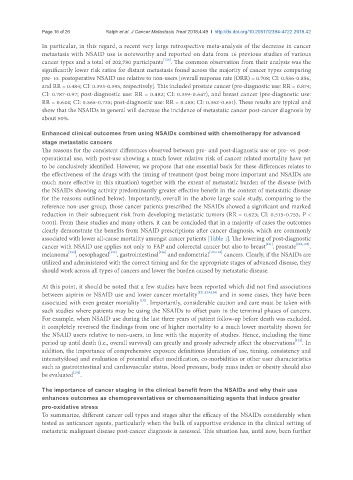Page 596 - Read Online
P. 596
Page 16 of 26 Ralph et al. J Cancer Metastasis Treat 2018;4:49 I http://dx.doi.org/10.20517/2394-4722.2018.42
In particular, in this regard, a recent very large retrospective meta-analysis of the decrease in cancer
metastasis with NSAID use is noteworthy and reported on data from 16 previous studies of various
[120]
cancer types and a total of 202,780 participants . The common observation from their analysis was the
significantly lower risk ratios for distant metastasis found across the majority of cancer types comparing
pre- vs. postoperative NSAID use relative to non-users [overall response rate (ORR) = 0.708; CI: 0.586-0.856,
and RR = 0.484; CI: 0.393-0.595, respectively]. This included prostate cancer (pre-diagnostic use: RR = 0.874;
CI: 0.787-0.97; post-diagnostic use: RR = 0.482; CI: 0.359-0.647), and breast cancer (pre-diagnostic use:
RR = 0.644; CI: 0.565-0.735; post-diagnostic use: RR = 0.485; CI: 0.362-0.651). These results are typical and
show that the NSAIDs in general will decrease the incidence of metastatic cancer post-cancer diagnosis by
about 50%.
Enhanced clinical outcomes from using NSAIDs combined with chemotherapy for advanced
stage metastatic cancers
The reasons for the consistent differences observed between pre- and post-diagnostic use or pre- vs. post-
operational use, with post-use showing a much lower relative risk of cancer related mortality have yet
to be conclusively identified. However, we propose that one essential basis for these differences relates to
the effectiveness of the drugs with the timing of treatment (post being more important and NSAIDs are
much more effective in this situation) together with the extent of metastatic burden of the disease (with
the NSAIDs showing activity predominantly greater effective benefit in the context of metastatic disease
for the reasons outlined below). Importantly, overall in the above large scale study, comparing to the
reference non-user group, those cancer patients prescribed the NSAIDs showed a significant and marked
reduction in their subsequent risk from developing metastatic tumors (RR = 0.623; CI: 0.515-0.753, P <
0.001). From these studies and many others, it can be concluded that in a majority of cases the outcomes
clearly demonstrate the benefits from NSAID prescriptions after cancer diagnosis, which are commonly
associated with lower all-cause mortality amongst cancer patients [Table 1]. The lowering of post-diagnostic
[121]
cancer with NSAID use applies not only to FAP and colorectal cancer but also to breast , prostate [122,123] ,
[125]
[124]
[126]
melanoma , oesophageal , gastrointestinal and endometrial [127,128] cancers. Clearly, if the NSAIDs are
utilized and administered with the correct timing and for the appropriate stages of advanced disease, they
should work across all types of cancers and lower the burden caused by metastatic disease.
At this point, it should be noted that a few studies have been reported which did not find associations
between aspirin or NSAID use and lower cancer mortality [121,129,130] and in some cases, they have been
[131]
associated with even greater mortality . Importantly, considerable caution and care must be taken with
such studies where patients may be using the NSAIDs to offset pain in the terminal phases of cancers.
For example, when NSAID use during the last three years of patient follow-up before death was excluded,
it completely reversed the findings from one of higher mortality to a much lower mortality shown for
the NSAID users relative to non-users, in line with the majority of studies. Hence, including the time
[122]
period up until death (i.e., overall survival) can greatly and grossly adversely affect the observations . In
addition, the importance of comprehensive exposure definitions (duration of use, timing, consistency and
intensity/dose) and evaluation of potential effect modification, co-morbidities or other user characteristics
such as gastrointestinal and cardiovascular status, blood pressure, body mass index or obesity should also
[132]
be evaluated .
The importance of cancer staging in the clinical benefit from the NSAIDs and why their use
enhances outcomes as chemopreventatives or chemosensitizing agents that induce greater
pro-oxidative stress
To summarize, different cancer cell types and stages alter the efficacy of the NSAIDs considerably when
tested as anticancer agents, particularly when the bulk of supportive evidence in the clinical setting of
metastatic malignant disease post-cancer diagnosis is assessed. This situation has, until now, been further

